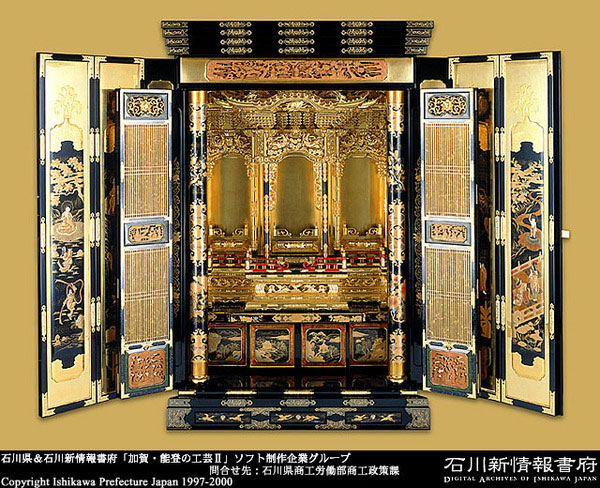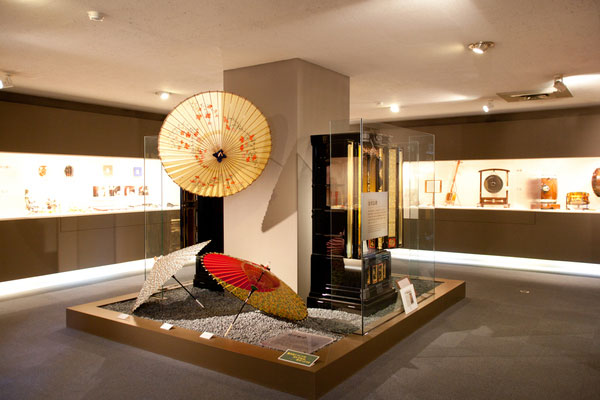
- Household Buddhist altars
- Ishikawa
Nanao Buddhist altar Nanao butsudan
Gorgeous gold leaf designs
Robust and traditional art
Description
What is Nanao Buddhist altar ?
Nanao Buddhist Altars called Nanao Butsudan in Japanese, are Buddhist altars produced in Nanao City, Ishikawa Prefecture. As part of the Hokuriku region where the Buddhist sect Jodo Shinshu became widely spread long ago, Ishikawa is home to many well-known Buddhist altar production areas such as Kanazawa Butsudan and Mikawa Butsudan. Nanao Butsudan is characterized by its robustness and splendor. As the Noto area, where Nanao City is located, is a mountainous area, finished Buddhist altars were carried on the mountain trail. The geographical constraints led to robustness in altars that could withstand transportation in this harsh environment. Using unique techniques such as hozogumi (tenon assembly using no nails) and niju-kagamiita (double-layer back boards behind a principal image and attendant images), Nanao Butsudan boasts a sturdy structure. Ishikawa has been performing steady growth as the center of exquisite craft production such as urushi lacquer work and gold leaf craftwork since ancient times. Subtle and profound techniques display their characteristics in Nanao Butsudan. Rich with gold leaf and Maki-e designs inlaid with mother-of-pearl, dual gable called niju hafu delivers a stately aura. While Kanazawa Butsudan is shrouded in gracefulness, Nanao Butsudan gives a luxurious but solemn impression.
History
History of Nanao Butsudan dates back to the early Muromachi Period, when the HATAKEYAMA clan as the provincial constables of Noto built handicraft workshops to protect urushi lacquer work, Maki-e and wood sculpture industries. It is at this time that the technical fundamentals of Nanao Butsudan were developed. In 1582, Toshiie MAEDA attracted more artisans after he moved into the Nanao Castle. There was a street bustling with nushi (lacquer painters) according to the record of the Kaga clan dating back to 1616. As Buddhist altar shops are called nushiya in Nanao, this meant that a town full of Buddhist artisans had already been formed at this time. The material for Nanao Butsudan, hiba arborvitae, a species of cypress, and cypress grew in extreme abundance in the Noto area, and the humid climate of Noto suited urushi lacquering. The Noto area respected the tradition of festivals and produced mikoshi portable shrines. Techniques for producing mikoshi and those for producing Buddhist altars were quite the same, and this is believed to be the reason why Buddhist altar production took root in Nanao. As the hub of the Noto area where the Jodo Shinshu sect was widely worshipped at the time, there was a large demand for altars in Nanao, and this allowed them to retain a dominant position in altar production to this day. In 1978, Nanao Butsudan gained a national recognition as a traditional craft for its long history and prodigious techniques.
General Production Process
- 1. Wood sculpture This process is carving wooden decorative pieces for the altar. Korean pine, ginkgo, Machilus thunbergii, red sandalwood and ebony is mainly used. Each piece of wood is carefully selected for its quality with no knots and cracks and it must be thoroughly dried to prevent warping. The wood is then cut out according to the dimensions of the carving parts. The design is directly drawn onto the cut wooden piece, and starting by a rough carving using chisels and sledges, the wooden piece goes through semi-fine carving and finish carving to apply a final finish to the surface.
- 2. Wooden base The exterior, pillars, ceiling, shoji paper doors and the edges of a Buddhist altar is built. Nanao Butsudan mainly uses hiba arborvitae and Japanese cypress for its quality with little warp and high durability. The wood must be dried completely before carefully selecting those with no cracks, knots or twists. The key feature of Nanao Butsudan is tenon frame assembly where the wooden parts are tenoned by inserting a tenon into a corresponding mortise hole to joint together with no nails. Tenon assembly adds robustness and durability, and makes the Buddhist altar easy to maintain as it can be disassembled easily.
- 3. Maki-e Maki-e is a technique of drawing exquisite patterns or designs on the Urushi-painted surface and sprinkling with gold powder or mother-of-pearl shells. Patterns or designs are drawn with urushi lacquer mixed with tin powder, dried, and then adorned with cut-out shells using animal glue. Another Maki-e technique is raising the pattern with urushi lacquer mixed with polishing powder and then sprinkling gold powder to deliver an exquisite finish.
- 4. Ornamental fine metal The metal ornaments and hinges for the front door, shoji paper door and pillars of a Buddhist altars are made. Exquisite patterns are engraved in a cut-out brass sheet using a Tagane chisel, and any unnecessary parts are removed. The engraved fine metal is finished gold-plated after the surface is smoothed.
- 5. Gilding Gold leaf is layered carefully over the Urushi-painted surface of the inside of the altar, inner sanctuary and wood sculpture. The surface is painted with raw urushi lacquer and wiped with a cotton cloth. Gold leaf is gently layered over the surface with chopsticks exclusively used for gold leaf, and is gently pushed down with floss silk while aligning the edges of ultrathin gold leaf.
- 6. Assembly Assembly is the final process of Nanao Butsudan. All the parts are assembled to complete one altar: the Urushi-painted base, inner sanctuary, wood sculpture and ornamental fine metal. Any flaws or dust are wiped off, and the altar is complete.
Where to Buy & More Information
Ishikawa Prefectural Museum of Traditional Arts and Crafts
 Photo:Ishikawa Prefecture Tourism League
Photo:Ishikawa Prefecture Tourism League
-
Address
-
Tel.+81-76-262-2020
-
ClosedApril to November: 3rd Thursday of the month / December to March: Thursdays / around the New Year
-
Business Hours9am to 5pm
-
Access1-1 Kenroku-machi, Kanazawa-shi, Ishikawa-ken
-
Website
See more Household Buddhist altars
- Osaka Buddhist altar
- Hikone Buddhist altar
- Iiyama Buddhist altar
- Nagoya Buddhist altar
- Kanazawa Buddhist altar
- Kawanabe Buddhist altar
- Kyo Buddhist altar
- Hiroshima Buddhist altar
- Mikawa Buddhist altar
- Kyo Buddhist altar equipment
- Nanao Buddhist altar
- Yamagata Buddhist altar
- Yame-fukushima Buddhist altar
- Nagaoka Buddhist altar
- Sanjo Buddhist altar
- Niigata-shirone Buddhist altar
- Owari Buddhist altar equipment































































































































































































































































































